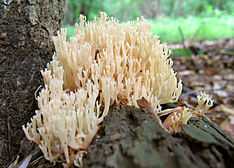Artomyces pyxidatus
| Artomyces pyxidatus | |
|---|---|
 | |
| Scientific classification | |
| Kingdom: | Fungi |
| Division: | Basidiomycota |
| Class: | Agaricomycetes |
| Order: | Russulales |
| Family: | Auriscalpiaceae |
| Genus: | Artomyces |
| Species: | A. pyxidatus |
| Binomial name | |
| Artomyces pyxidatus (Pers.) Jülich (1982) | |
| Synonyms[1] | |
|
Clavaria pyxidata Pers. (1794) | |
| Artomyces pyxidatus | |
|---|---|
|
| |
| smooth hymenium | |
| no distinct cap | |
| hymenium attachment is irregular or not applicable | |
| lacks a stipe | |
| spore print is white | |
| ecology is saprotrophic | |
| edibility: edible | |
Artomyces pyxidatus is a coral fungus that is commonly called crown coral or crown-tipped coral fungus. Its most characteristic feature is the crown-like shape of the tips of its branches.
Artomyces pyxidatus can be observed throughout North America during the growing season, producing its fleshy, coral-like fruiting bodies on decaying wood. Basidia and basidiospores are produced on the surfaces of the branches. These fungi are considered edible when cooked, although some people may experience gastrointestinal upset, especially after eating a large quantity. The raw fruiting bodies have a peppery taste which usually disappears when cooked.
The sesquiterpenes pyxidatols A-C, tsuicoline E and omphadiol have been obtained from the liquid culture of this fungus.[2]
References
- ↑ "Artomyces pyxidatus (Pers.) Jülich 1982". MycoBank. International Mycological Association. Retrieved 2011-01-18.
- ↑ Zheng Y-B, Lu C-H, Zheng Z-H, Lin X-J, Su W-J, Shen Y-M. (2008). "New sesquiterpenes from edible fungus Clavicorona pyxidata". Helvetica Chimica Acta 91 (11): 2174–80. doi:10.1002/hlca.200890235.
External links
 Media related to Artomyces pyxidatus at Wikimedia Commons
Media related to Artomyces pyxidatus at Wikimedia Commons- Clavicorona pyxidata at Tom Volk's Fungi